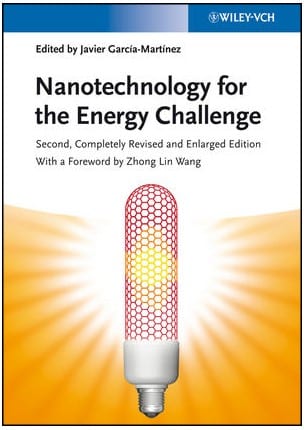 Nanotechnology for the Energy Challenge, 2nd Edition
Nanotechnology for the Energy Challenge, 2nd Edition
Javier García-Martínez (Editor), Zhong Lin Wang (Foreword by)
ISBN: 978-3-527-33380-6
Hardcover / E-book
664 pages
$210.00 / $169.99
Click here for more information
Reviewed by Professor Nazario Martín, University Complutense of Madrid and IMDEA-Nanoscience
The book is dedicated to energy as the most important challenge currently facing mankind. However, in contrast to many other books devoted to this topic, the contribution of nanotechnology to the energy problem is what makes it different. This singularity of the book has been highly recognized among the scientific community with a great success from the editorial viewpoint since, just three years after the first edition published in 2010, a new edition comes out. However, this second edition has been highly modified and improved – most of the chapters in the book have been enlarged to include the new advances in their respective fields. Furthermore, three new chapters have been added in this edition showing the last significant novelties bursting into the energetic sector, namely graphene, piezoelectric nanomaterials and nanocatalysis, which nicely complement the previous chapters.
The book is divided in three different sections: Production, Storage and Sustainability. Needless to say that, if energy production is a key issue, storage and sustainability are critical in order to maintain the development of renewable energies with high efficiency, economy, network, etc.
Thus, the book contains eighteen self-consistent and independent chapters, being the first eight ones those corresponding to part one, dealing with “Sustainable Energy Production”. Specifically, each chapter is dedicated to a hot topic in the field, being the first chapter “Nanotechnology for Energy Production” written by the editor of the book, Prof. Javier García-Martinez and colleagues. Important topics such as materials for photoelectrochemical devices, thermal-electrical energy conversion, piezoelectric effects in energy harvesting, graphene for energy production and storage, nanomaterials for fuel cell technologies, nanocatalysis for iron-catalyzed Fischer-Tropsch synthesis and nanomaterials for hydrogen production are also contained in this section and, altogether, provide a thorough view of the importance of new materials for achieving a sustainable usage of energy.
Part two of the book is devoted to “Efficient Energy Storage” and is constituted by four chapters focusing on those nanomaterials for hydrogen storage, electrochemical energy storage including nanostructured and carbon-based materials, and those nanotechnologies enabling high-performance superconductors for energy applications.
Part three of the book is focused on “Energy Sustainability” and contains the last six chapters which nicely complement the previous parts of the book. Thus, those unconventional approaches for the conservative use of energy (green nanofabrication) and the use of nanocatalysis for fuel and biofuel production are presented. A chapter follows which is dedicated exclusively to the nanotechnology for the carbon dioxide capture, a hot topic in modern science, and the last two chapters deal with promising nanostructured organic light-emitting devices (OLEDs) and electrochromic devices.
It is important to note that this authoritative book has been written by a collection of great experts in their respective fields with renowned names such as those of professors G. Whitesides (nanofabrication), M. Grätzel (photovoltaic cells) and J.-M. Tarascon (batteries), just to name a few. To these names it should also be added that of Prof. Zhong Lin Wang, currently the editor-in-chief of the journal Nano Energy, who is the responsible for the “Foreword”.
To sum up, this new edition of the book with its eighteen chapters and over 650 pages constitutes the most complete and updated monograph devoted to energy in its many different aspects, namely production, transformation, storage and usage. Most importantly, the aforementioned issues are considered from the sustainability, efficiency and economic viewpoints.
A most remarkable feature of this book is, however, the way in which it has been written with a clear message based on the concept of energy sustainability and environmental impact. Furthermore, the necessity of new available materials, as well as the important contribution of nanotechnology for their nanostructured fabrication leading to a more sustainable and rational use of energy is stressed along the book.
This comprehensive approach on nanotechnology applied to energy brings together two currently critical and important topics and makes this book something completely new and singular in the huge bibliography devoted to broad fields such as nanotechnology and energy.
The book is edited with plenty of figures, schemes and tables which make it readable and ease to follow and, in general, the chapters are clearly presented with an initial introduction section which helps to introduce the reader to the different topics. The bibliography contained in the book, as a whole surpassing 1800 references, constitute an important pool of updated scientific papers which give an added value to this book and reveal the state of the art in the different fields related with nanotechnology for energy. No doubt, this is a valuable information for specialized researchers but also for those researchers of related topics and scientists from academy. Overall, this book is highly recommended for those readers interested in getting an overall idea of the important contributions of nanoscience and nanotechnology to the central problem of energy.
Because of the current pollution, global warming and degradation of the planet, a new era based on non-contaminating renewable energies is currently a priority and an unsolved scientific challenge in modern science. In this regard, the present book is a significant contribution to the hope that a solution to the energy problem is possible.

















